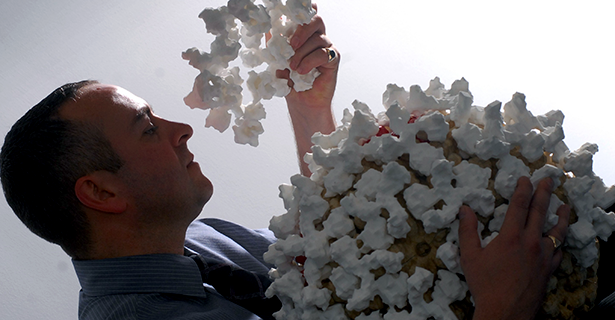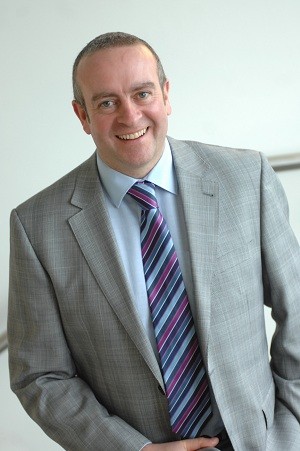Rapid Prototyping
Interview with Dr Greg Gibbons, Additive Manufacturing, WMG, University of Warwick
Published August 2010
 Additive Layer Manufacturing is a general term used to refer to a range of processes that make solid objects from 3D computer models. In most cases this is achieved by printing thin layers of material on top of one another; sometimes layers are printed out separately and assembled afterwards. The starting material might be a powder or a liquid but the ‘printing process’ works by transforming this powder or liquid into a solid only where the design dictates, just like a printer draws lines of tiny dots one after each other to build up an image or page of text. This technique is not a recent invention but some people still needlessly worry that the products of this process are not as strong as if they had been made using traditional methods, like injection moulding. Dr Greg Gibbons, head of Warwick Manufacturing Group’s Rapid Prototyping and Tooling team, is always working on new ways to develop this method; part of his job is explaining to people just what ALM can achieve.
Additive Layer Manufacturing is a general term used to refer to a range of processes that make solid objects from 3D computer models. In most cases this is achieved by printing thin layers of material on top of one another; sometimes layers are printed out separately and assembled afterwards. The starting material might be a powder or a liquid but the ‘printing process’ works by transforming this powder or liquid into a solid only where the design dictates, just like a printer draws lines of tiny dots one after each other to build up an image or page of text. This technique is not a recent invention but some people still needlessly worry that the products of this process are not as strong as if they had been made using traditional methods, like injection moulding. Dr Greg Gibbons, head of Warwick Manufacturing Group’s Rapid Prototyping and Tooling team, is always working on new ways to develop this method; part of his job is explaining to people just what ALM can achieve.
The possibilities are literally endless: any 3D solid object can be printed out.
Two of the many processes which are used in ALM are laser sintering and stereolithography. Laser sintering is used to make objects out of polymers and metals. The starting material is a powder, such as titanium or cobalt chrome. A laser is used for the ‘printing’; infrared rays melt the powder into a solid. Each time a layer is printed the plate supporting the structure moves down by a tiny amount and a new complete layer of powder is distributed over the whole plate. By the end the solid object is buried in a cuboid of powder and the unmelted powder has to be brushed away. Stereolithography works on the same principle but the starting material is liquid resin. Cross links within the resin that make it solid are created when it is exposed to UV light. The base plate starts just below the surface of the vat of resin and sinks into the liquid during the printing process. The results can be mind-boggling: Dr Gibbons can print out a toy car already with wheels attached that spin.
The possibilities are literally endless: any 3D solid object can be printed out. That object can be made out of several different materials, or different colours which expands the model-maker’s options further still. However it is important to make a distinction between the two main uses of this process. The rapid conversion of a digital design into solid reality means that it can be used to great effect in design. Everyone from architects to product designers can use the technique to make models. These are not necessarily used as prototypes, often the sole purpose is to produce an impressive visual aid. Bureaus provide this commercial service and the price is coming down. It is already possible to buy a basic printer for £500 and Dr Gibbons envisages a time in the not too distant future when it will be normal for us to download designs from the internet, for things like children’s toys or spare parts to kitchen appliances, and print them out.
The second distinct use is in manufacturing. At the moment ALM has not replaced injection moulding wholesale simply because it is not fast enough. “It is far too slow,” explained Dr Gibbons. “Mass customisation is where it can come in useful. Tailoring mass produced parts for the individual can be a lot more cost-effective than making a new mould each time you need to tweek a design.” Potentially massive savings could be made by using this method to make carefully designed parts for cars or aeroplanes: “At the moment heat protective liners are used inside aeroplane engines. They have to be replaced every 200 hours. 3,000 holes have to be drilled into a metal sheet at 1€ a hole. ALM could bring the cost of manufacturing these liners right down.” The problem is that these parts cannot fail; they have to be made out of materials that retain their strength at very high temperatures. A general prejudice against ALM is that the parts produced are weak or have air bubbles trapped inside. This is not true now that the techniques has been developed and Dr Gibbons invests in research to provide further evidence to nervous industry insiders. However they are still working out how to adapt the printing process to be used on materials that withstand extreme temperatures: “We have received funding from the ESRC for a PHD project that will be looking at how we can use lasers to melt high energy nickel. This material is traditionally non-weldable so trying to meld the layers to each other is proving problematic.”
Potentially massive savings could be made by using this method to make carefully designed parts for cars or aeroplanes...
Being an expert in ALM means that Dr Gibbons is often invited to work on other people’s projects. Dr Gibbons enjoys this part of his job: “If you work in isolation you can do certain things but you miss a lot of the picture. Collaborations are essential.” He is most excited by the medical applications of ALM, like the customised digital hearing aids now sold by Siemens-Phonak. They take a scan of your ear’s canal and produce a case for the hearing aid that fits perfectly. The hearing aid is more comfortable to wear and performs its function better because less outside noise gets in. Dr Gibbons was also recently asked to solve a problem challenging a team researching the genomic causes of emphysema. In order to validate their results they need to collate and compare CT scans from all over Europe. There are over 900 scanners and they were calibrated differently which meant that scans of the same lungs did not necessarily result in the same quality image. The ingenious solution was to manufacture a set of phantom lungs. Different plastic lungs were made to resemble human lungs at certain levels of damage. The set of lungs were then shipped around Europe and used to calibrate the scanners: “It worked really well. We set the lungs in ‘solid water’ [a plastic with the same density of water]. Not only did it solve the inconsistency problem but it lowered the standard deviation of error as well. All readings were much more accurate as a result.”
The success of this project has led onto another commission. Dr Gibbons contributed to a €12 million successful bid for a research project looking at Chronic Obstructive Pulmonary Disorder. He has to make models of lungs that have the exactly same mechanical properties as human lungs so that they can be used to measure the flow dynamics. This will push Dr Gibbons to developed the ALM method further still as it will require the manufacture of models out of flexible material: “In theory it is possible. The challenge is to make it happen in practice.” He starts work in the Autumn.
 Dr Gibbons, now a senior research fellow at WMG (Warwick Manufacturing Group), gained a BSc and a PhD, both in physics, at Warwick. After a period of post-doctoral research at Warwick, he left to become a patent editor with intellectual property firm Derwent Information in London. In 1997 he returned to Warwick as a research assistant working on a the EPSRC funded project ?IMI Spray Mould?, developing tooling for composite component manufacture for the automotive and aerospace industries. He then became principal investigator for CASPUR (Coating and Processing for Sustainable Upgrade and Repair of Tooling), a project again backed by the WIMRC. More recently, Dr Gibbons rapid prototyping work has extended to the field of healthcare and biomedical applications. Dr Gibbons is a member of the EPSRC College and a committee member of the Rapid Prototyping and Manufacturing Association.
Dr Gibbons, now a senior research fellow at WMG (Warwick Manufacturing Group), gained a BSc and a PhD, both in physics, at Warwick. After a period of post-doctoral research at Warwick, he left to become a patent editor with intellectual property firm Derwent Information in London. In 1997 he returned to Warwick as a research assistant working on a the EPSRC funded project ?IMI Spray Mould?, developing tooling for composite component manufacture for the automotive and aerospace industries. He then became principal investigator for CASPUR (Coating and Processing for Sustainable Upgrade and Repair of Tooling), a project again backed by the WIMRC. More recently, Dr Gibbons rapid prototyping work has extended to the field of healthcare and biomedical applications. Dr Gibbons is a member of the EPSRC College and a committee member of the Rapid Prototyping and Manufacturing Association.
